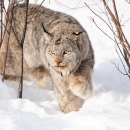A network of trail cameras capture life on the refuge year-round. This project began in 2016, starting with 16 cameras deployed in the fall and kept active all winter. Since then, the number of cameras has expanded to 34. Through 2020, 467,739 photos were recorded. Of those, 12,211 contained a lynx and 49,049 contained a photo of a terrestrial mammal or bird.
This effort has revealed that the Yukon Flats National Wildlife Refuge, at times, contains a tremendous biomass of Canada lynx as they respond to snowshoe hare population cycling. Results indicate lynx were the most common terrestrial species, occurring more frequently in our photos than other furbearers (see related Northwest Boreal Forest Lynx Study). Wolf, wolverine and red fox were the next most abundant furbearers, with coyote being rare. Mink and American marten were probably underrepresented because their small body size does not always trigger the camera.
The cameras used in this study trigger through a combination of motion and heat. The camera senses the temperature of the ambient environment it faces. When an object of different temperature moves through the infrared sensors, the camera activates. This combination of heat and motion minimizes false triggers, for example, from moving leaves or grass. The cameras operate on 12 lithium AA batteries that last a year, and down to temperatures as low as minus 45 Fahrenheit.
Data collected in this study can be used to inform harvest proposals to federal and state regulatory boards. Our future goals are to investigate spatial variation in the occupancy of furbearers across Yukon Flats National Wildlife Refuge.



